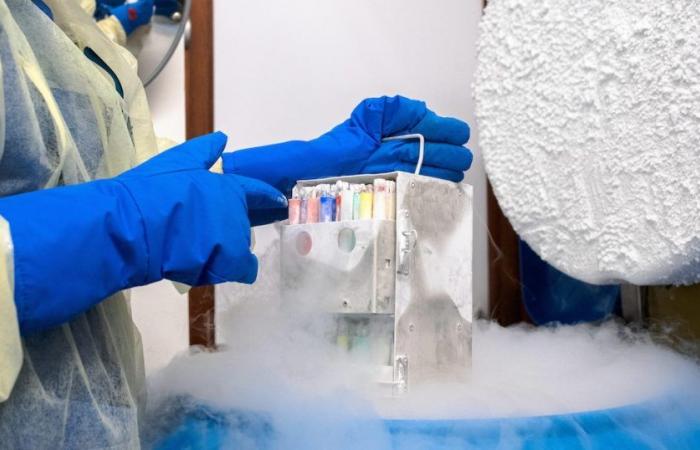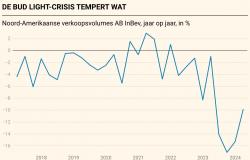
After repeated attempts in the top-scoring centers, more than 70 percent of women under 36 have a child. In the worst performing clinics this is about 50 percent. The figures are below average, especially in some Walloon centers and the Jan Palfijn hospital in Ghent.
This is evident from the most recent data on fertility clinics, from 2021, which The morning requested on the basis of the Public Information Act (WOB). It is known that there are differences between fertility centers – there are eighteen in our country. But concrete figures have so far remained internal. “As a patient you have little to rely on, and that is a shame,” says Marijke Merckx, chairman of patient association De Verdwaalde Ooievaar. “We have been asking for more transparency for some time.”
Not only does the chance of success of an IVF process differ, the risk of twins is also not the same everywhere. For example, the chance of going home with two babies is more than three times greater in some centers than in others, because more than one embryo is often transferred at the same time, contrary to recommendations. “Some clinics still have some explaining to do,” says fertility doctor Herman Tournaye (VUB).
To properly interpret the data, you need some insight into how IVF works. A woman first receives hormones to stimulate her ovaries, after which her eggs are harvested. In vitro fertilization then produces a variable number of embryos. Sometimes a ‘fresh’ embryo is transferred and the others are frozen for later attempts. Some centers often freeze all embryos first to avoid the risk of complications due to rapid transfer. Such a cycle can be repeated six times with refund.
A first indicator in the report that The morning asked, looks at the chance of having a child per fresh embryo transferred in the first cycle, in women younger than 36. “A good indicator for the quality of your IVF lab,” according to Tournaye. That chance averages 33.8 percent, but varies from just over 15 percent to more than 45 percent. Important: chances of success with IVF decrease rapidly with age, but the group younger than 36 serves as a reference for comparisons between centers.
These figures only concern fresh embryos. The frozen embryos are included in the so-called ‘cumulative chance of success’. This shows the likelihood that women who started an IVF process in 2018, 2019 and 2020 would have had a child at the end of 2021 – and therefore after repeated attempts with both fresh and frozen embryos. That chance varies from just over 50 percent to just over 80 percent. The data also show that the chance of having a child after one or two cycles in, for example, the UZ Antwerp or the AZ Sint-Jan in Bruges is greater than after five or six cycles in Jan-Palfijn or the Hôpital Universitaire Saint-Pierre.
These figures are an underestimate, because some women dropped out prematurely or did not have the opportunity to complete six cycles at the end of 2021. A more ‘optimistic’ calculation assumes that these women keep trying. In that case, the chance varies from just over 70 to almost 100 percent. The actual chances of success will be somewhere in the middle.
Each way of measuring success rates has its pros and cons. Some centers are very selective and only transfer the very best embryos, resulting in good figures per transfer. But because some of the rejected embryos might still have resulted in a pregnancy, this approach may result in a lower cumulative chance of having a child. “It is important that centers communicate honestly about this and weigh together with the patient what is most important,” says bioethicist Heidi Mertes (UGent). “Not everyone has the same capacity.”
More chance of multiple births
The data also reveal striking differences in the risk of multiple births. During a first cycle, IVF centers are only allowed to transfer one embryo at a time. This rule was introduced to limit the risk of multiple births, with a greater risk of premature birth and other complications. Two embryos may be transferred in subsequent cycles, although this is not recommended.
This clearly happens more often in some centers, because the chance of twins (5.3 percent on average) varies from a few percent in the AZ Middelheim to almost 15 percent in the Grand Hôpital De Charleroi. “More than 5 percent of twins are actually outdated,” says Dutch fertility expert Sebastiaan Mastenbroek (Amsterdam UMC).
“There are clearly centers that transfer multiple embryos in a way that is far too accessible and thus take unnecessary risks,” says fertility doctor Dominic Stoop (UZ Gent), board member of the Belgian Society for Reproductive Medicine (BSRM).
Based on research in this area, a recent medical guideline from the European Society of Human Reproduction and Embryology concludes that there is no good justification for transferring multiple embryos. “That offers no advantage whatsoever,” says Mertes, who co-wrote the guideline. “In the interest of the child’s health, it is better to transfer embryos one by one.”
Embryos can be transferred after three or five days. Some centers, such as UZ Gent, only do this on day five. Others, such as the University Hospital Saint-Luc, hardly do so.
There is a tendency to implant more embryos on day five. One of the reasons for this is that natural selection takes place during those few extra days in the lab, resulting in the most viable embryos remaining on day 5. This may save women a fruitless attempt. “For this you have to have confidence in your lab,” says Tournaye. “Some centers prefer to transfer embryos quickly because they fear that too few will otherwise be left.”
Replacing the baby on day three or five does not seem to make a big difference to the child’s health. “If you have a good lab, it seems better to choose day five and thus spare women the suffering of a failed attempt,” Mertes concludes.
Inadequate data
The data should be interpreted with caution. Various factors can influence the chances of success in a clinic, such as the profile of the patients. Some clinics treat more patients with specific conditions that lower their chances, such as endometriosis, or who have already made fruitless attempts elsewhere. “This mainly occurs in university centres, less so in small clinics,” says Stoop.
Women from lower socio-economic classes, who, for example, smoke more and are more likely to be overweight, also have a smaller chance of a successful trajectory. “You cannot undo that impact even with a good IVF lab,” says Stoop.
In addition, not all centers keep accurate records of whether a pregnancy results in a live birth. This is difficult, for example, in some centers to which many patients are referred who then leave to give birth elsewhere. That also clouds the data.
“We cannot compare apples and oranges,” says Wim Decleer, head of the fertility center in Jan Palfijn, which scores poorly on a number of indicators. “As a OCMW hospital, we see more patients with an unhealthy lifestyle and medical problems. Our patients often have few or weak embryos, which explains why we implant two embryos more often on day three and more often two embryos to increase the chance of having a child. If you take all that into account, our results are not bad at all. Several clinics refuse women with an unfavorable profile. That produces good statistics. We do not go for the best statistics, but for people’s individual choice.”
It is not clear where exactly centers set the bar for refusing patients. “You can discuss how good or bad such a refusal is,” says Mertes. “It can also be in the interest of the health of mother and child.”
The figures also show that there is currently no good data available to enable an objective comparison between centers. “That has never been a priority,” says Stoop. “We would like to contribute to this, but the government must also release resources to collect better data.”
According to Mastenbroek, the results should at least lead to introspection. “Research must show whether there are good explanations for the differences,” he says. “If they are due to a difference in quality, centers must learn from each other what can be improved. That happens far too little now.”
Centers receive an annual report containing their own results, in addition to the anonymized figures of the others. The idea is that this will encourage quality improvement, but the question is whether that is enough. “When centers repeatedly score poorly, it is problematic,” says Tournaye. “There are now no consequences for those who underperform, and therefore little incentive to do better. Hopefully, more and better public reporting will change that.”
All hospitals were given the opportunity to explain their results. They were also asked where they see room for improvement, and whether they are in favor of more public reporting.
Tags: Figures provide insight differences fertility clinics IVF centers explaining
-




